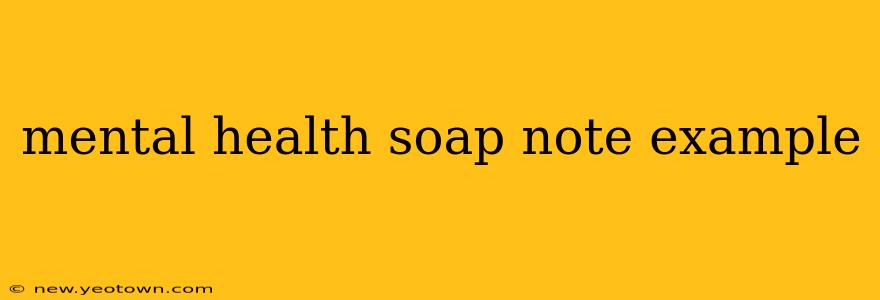A Day in the Life: Crafting a Compelling Mental Health Soap Note
The quiet hum of the office, the gentle tap-tap-tap of my keyboard – these are the sounds of my day, a day spent navigating the intricate landscape of mental health. Today, I'll walk you through the process of creating a soap note, illustrating with a fictional case study to show you how it's done. This isn't just about ticking boxes; it's about telling a story – a story of a patient's journey, their struggles, and their hopes for healing.
The Patient: Sarah Miller, 28
Sarah is a vibrant young woman, a graphic designer grappling with anxiety and occasional panic attacks. She's articulate, insightful, and deeply committed to managing her mental health. Our session today focused on her recent stressors and coping mechanisms.
The SOAP Note Structure: A Framework for Storytelling
The SOAP note is our framework, an acronym that guides our narrative: Subjective, Objective, Assessment, Plan. Let's unpack each section:
S: Subjective – Sarah's Voice
This section is all about Sarah's perspective. It's a synthesis of her words, her feelings, her experiences during the session. It's crucial to record her narrative accurately and empathetically.
- "Sarah reported increased anxiety this week, triggered by an upcoming deadline at work. She described feeling overwhelmed, experiencing difficulty sleeping, and noticing a heightened sense of irritability. She mentioned a panic attack yesterday afternoon, characterized by rapid heart rate, shortness of breath, and a feeling of impending doom."
O: Objective – Observable Data
This section focuses on concrete observations – things we can measure or see. It moves beyond Sarah's subjective feelings to include quantifiable data.
- "Affect: Anxious, but engaged in the session. Mood: Moderately depressed. Speech: Coherent, fluent. Thought process: Linear, goal-directed. Insight and judgment: Intact."
A: Assessment – Weaving a Narrative
This is where we synthesize the subjective and objective information to form a clinical picture. We analyze the data and identify potential diagnoses, considering differential diagnoses and weighing the evidence.
- "Sarah's presentation is consistent with a diagnosis of Generalized Anxiety Disorder (GAD), exacerbated by current work-related stressors. Her panic attack suggests the possibility of Panic Disorder, although further assessment may be needed. No evidence of psychosis or other severe mental illness."
Frequently Asked Questions (Addressing Common Concerns)
What are the common components of a mental health soap note?
The SOAP note format ensures a standardized approach to documentation. Key components include the patient's subjective experience, observable behaviors, a clinical assessment integrating both, and a detailed treatment plan. It's essential to record medication details and any changes to the treatment plan.
How do I document a patient's progress in my soap note?
Progress documentation within the assessment section is key. This might include observations such as improved mood, reduced anxiety symptoms, or increased engagement in therapy. Quantifiable metrics, if available (e.g., scores on standardized anxiety scales), are valuable for tracking progress and making adjustments.
What is the significance of using a SOAP note format in mental health documentation?
The SOAP format offers structure and clarity, providing a comprehensive overview of a patient's case. It facilitates communication among healthcare professionals, ensures continuity of care, and supports informed decision-making. Further, good documentation protects both the patient and the clinician.
What is the importance of a well-written soap note?
A well-written soap note is crucial for effective communication, accurate diagnosis, appropriate treatment planning, and continuous monitoring of patient progress. It also serves as legal documentation, protecting both the patient and the clinician.
P: Plan – Charting the Course
This section outlines the steps we'll take moving forward. This isn't just a list of tasks; it's a strategic roadmap for Sarah's healing journey.
- "Continue weekly therapy sessions. Explore cognitive-behavioral techniques (CBT) to manage anxiety and panic symptoms. Discuss relaxation techniques, such as deep breathing and progressive muscle relaxation. Consider referral to a psychiatrist for medication evaluation if symptoms persist or worsen. Schedule follow-up appointment in one week."
Conclusion: The Art of Documentation
Writing a soap note isn't just about fulfilling a bureaucratic requirement. It’s about crafting a narrative that reflects the patient's experience and guides their path to recovery. It's about empathy, precision, and a commitment to providing the best possible care. It's about telling a story, one session at a time.

